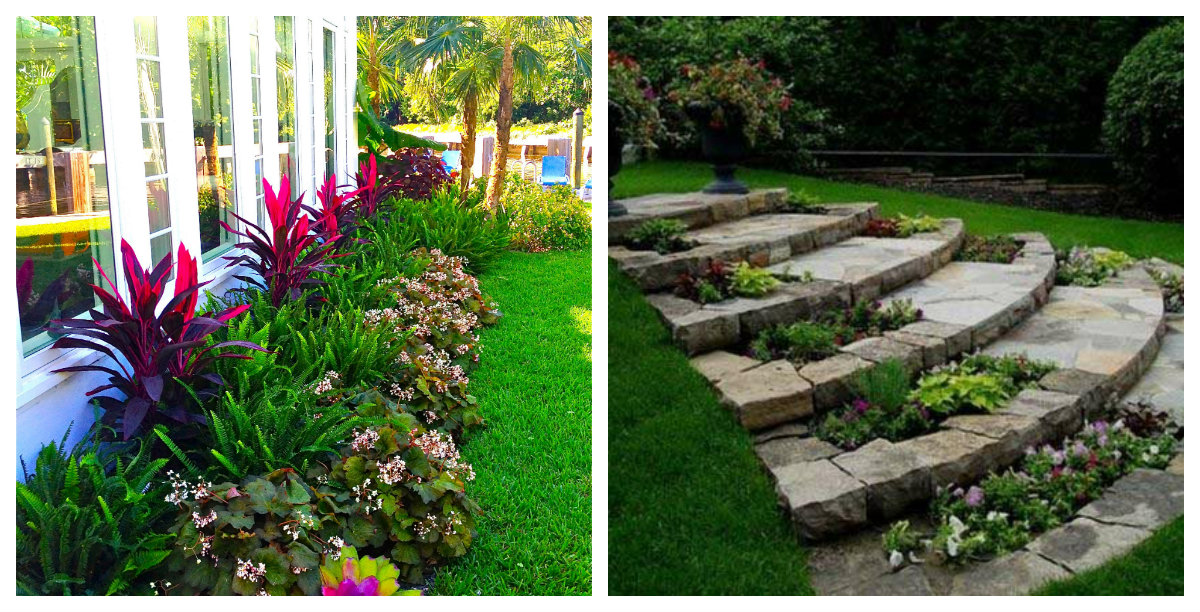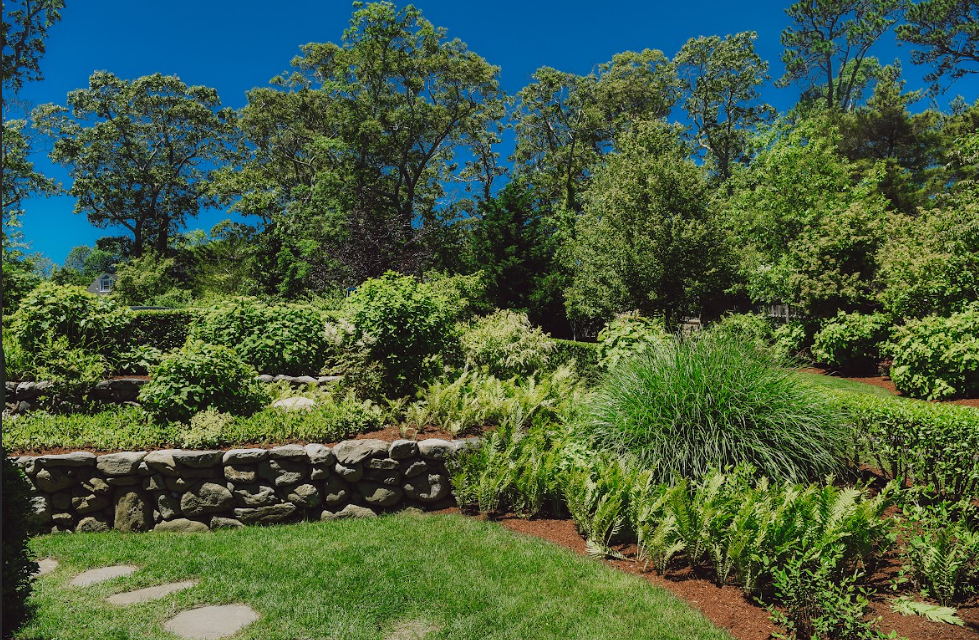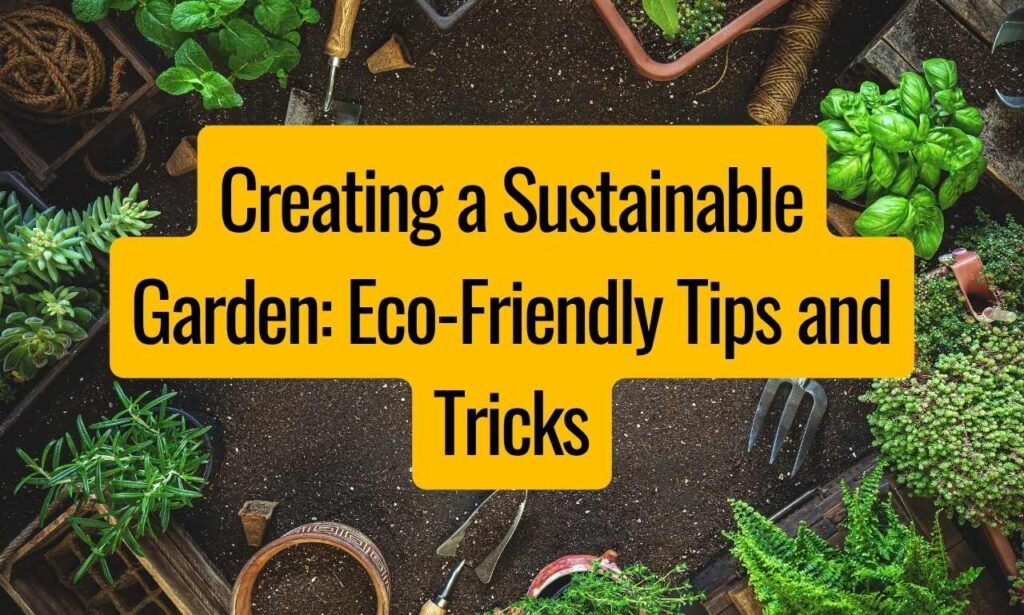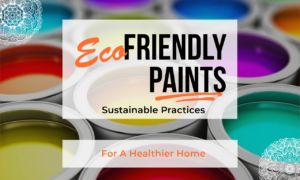Creating a sustainable garden involves using eco-friendly practices and minimizing waste. Utilize native plants and organic materials for optimal results.
A sustainable garden not only beautifies your space but also benefits the environment. By incorporating native plants, you can reduce water usage and support local ecosystems.
Organic materials like compost and natural fertilizers enrich the soil without harmful chemicals. Choose drought-resistant plants to conserve water and implement rainwater harvesting systems for irrigation.
Mulching helps retain moisture and suppress weeds, reducing the need for chemical treatments. Companion planting and crop rotation maintain soil health and boost plant growth. These eco-friendly tips ensure your garden thrives while minimizing environmental impact, promoting a balanced and sustainable ecosystem.
Introduction To Sustainable Gardening
Sustainable gardening is a way to grow plants in harmony with nature. It involves using eco-friendly methods that help the environment. By creating a sustainable garden, you can reduce waste, save water, and support local wildlife.
Benefits For The Environment
Sustainable gardens offer many benefits to the environment. Here are some key advantages:
- Reduces waste: Use compost and recycle garden waste.
- Saves water: Collect rainwater and use drip irrigation.
- Supports wildlife: Plant native species that attract bees and butterflies.
- Improves soil health: Use organic fertilizers and avoid chemicals.
Personal Advantages
Gardening sustainably also has many personal benefits. Here are a few:
- Healthier produce: Grow your own organic fruits and vegetables.
- Cost savings: Reduce spending on water and garden supplies.
- Stress relief: Enjoy the calming effects of nature.
- Physical activity: Gardening provides good exercise.
Principles Of Sustainability In Gardening
Creating a sustainable garden is not only good for the environment but also for your health. Understanding the principles of sustainability can help you make better choices. This section will guide you through key principles that will make your garden more eco-friendly.
Conservation Of Resources
Conserving resources is essential for a sustainable garden. Here are some tips:
- Use rain barrels to collect rainwater for irrigation.
- Install a drip irrigation system to minimize water waste.
- Choose native plants that require less water and care.
Using organic compost helps reduce waste and enriches the soil. You can make compost at home using kitchen scraps and garden waste. This reduces landfill waste and provides rich nutrients for your plants.
Another way to conserve resources is by mulching. Mulch helps retain moisture in the soil and reduces the need for frequent watering. It also prevents weed growth, saving you time and effort.
Biodiversity And Ecosystem Health
Encouraging biodiversity is crucial for a healthy garden ecosystem. Diverse gardens attract beneficial insects and pollinators. Here are some ways to promote biodiversity:
- Plant a variety of flowers and shrubs to attract different species.
- Create a wildflower meadow for bees and butterflies.
- Include a water feature like a pond to support aquatic life.
Integrated Pest Management (IPM) helps maintain biodiversity. IPM uses natural predators and organic methods to control pests. This reduces the need for harmful pesticides.
Another way to support ecosystem health is by planting companion plants. These plants support each other’s growth and deter pests. For example, marigolds can repel nematodes that harm tomatoes.
Maintaining healthy soil is also vital. Use crop rotation to prevent soil depletion. Rotate different types of plants to keep the soil fertile and balanced.
Designing Your Sustainable Garden Layout
Creating a sustainable garden layout is essential for an eco-friendly garden. A well-designed layout makes the most of your space and resources. It helps to reduce waste and ensures that your garden thrives. Here are some tips and tricks to help you design the perfect sustainable garden layout.
Choosing The Right Location
Choosing the right location for your garden is crucial. It can make a big difference in the success of your garden. Here are some factors to consider:
- Sunlight: Ensure your garden gets enough sunlight. Most plants need at least 6 hours of direct sunlight daily.
- Soil Quality: Check the soil quality. Healthy soil is key to a thriving garden. Test your soil for nutrients and pH levels.
- Water Access: Make sure you have easy access to water. This will make watering your plants more convenient.
- Wind Protection: Choose a location that offers protection from strong winds. This will help prevent damage to your plants.
Maximizing Space Efficiency
Maximizing space efficiency in your garden helps you grow more plants in less space. Here are some strategies to help you make the most of your garden space:
- Vertical Gardening: Use vertical gardening techniques. Grow plants on trellises, walls, or stacked containers.
- Companion Planting: Plant compatible plants together. This can help them grow better and save space.
- Succession Planting: Use succession planting to grow multiple crops in the same space. When one crop is harvested, plant another in its place.
- Intercropping: Intercrop fast-growing plants with slow-growing ones. This helps you make the most of your available space.
Here is a simple table to help you plan your garden layout efficiently:
| Technique | Description |
|---|---|
| Vertical Gardening | Grow plants on trellises, walls, or stacked containers. |
| Companion Planting | Plant compatible plants together to save space. |
| Succession Planting | Grow multiple crops in the same space one after another. |
| Intercropping | Plant fast-growing plants with slow-growing ones. |
By choosing the right location and maximizing space efficiency, you can create a sustainable garden layout. This will help your garden thrive while being eco-friendly.
Selecting Plants For Sustainability
Creating a sustainable garden begins with choosing the right plants. Selecting plants for sustainability ensures your garden thrives while being kind to the planet. This section guides you through picking the best plants for an eco-friendly garden.
Native Species
Native species are plants that occur naturally in your area. They are adapted to the local climate and soil. This makes them a perfect choice for sustainable gardening.
- They require less water.
- They need fewer fertilizers and pesticides.
- They support local wildlife.
Here’s a quick look at the benefits of native species:
| Benefit | Description |
|---|---|
| Water Conservation | Native plants need less watering. |
| Reduced Chemical Use | They thrive without fertilizers and pesticides. |
| Wildlife Support | They provide food and habitat for local fauna. |
Drought-resistant Varieties
Drought-resistant varieties are perfect for areas prone to dry spells. These plants survive with minimal water.
- They save water.
- They reduce maintenance time.
- They prevent soil erosion.
Examples of drought-resistant plants include:
- Succulents
- Lavender
- Yarrow
Drought-resistant plants are a smart choice for any sustainable garden. They help conserve resources and ensure your garden looks vibrant year-round.
Soil Health And Organic Practices
Creating a sustainable garden starts with healthy soil and using organic practices. These methods help keep the garden thriving and the environment safe. This section will focus on two key areas: Composting Essentials and Avoiding Chemical Fertilizers.
Composting Essentials
Composting is a natural way to recycle organic waste into rich soil. It improves soil structure, retains moisture, and adds nutrients.
- Use kitchen scraps like fruit peels, vegetable cuttings, and coffee grounds.
- Add yard waste such as leaves, grass clippings, and small branches.
- Ensure a balance of green and brown materials for effective composting.
- Turn the compost pile regularly to speed up the decomposition process.
- Keep the compost moist but not waterlogged.
Here is a simple table to help you remember what to compost:
| Green Materials | Brown Materials |
|---|---|
| Fruit Peels | Dry Leaves |
| Vegetable Cuttings | Twigs |
| Grass Clippings | Cardboard |
| Coffee Grounds | Newspaper |
Avoiding Chemical Fertilizers
Chemical fertilizers can harm the soil and environment. They can also be dangerous for pets and children. Instead, use organic fertilizers to keep the soil healthy.
- Manure: Use well-rotted manure from cows, chickens, or horses.
- Bone Meal: This adds phosphorus, promoting root growth.
- Fish Emulsion: A great source of nitrogen, perfect for leafy plants.
- Seaweed Fertilizer: Provides trace minerals and helps plants resist disease.
- Cover Crops: Plant cover crops like clover to enrich the soil naturally.
Here are some tips to avoid chemical fertilizers:
- Test your soil to know what nutrients it needs.
- Use compost to add organic matter and nutrients.
- Rotate crops to avoid depleting the soil.
- Mulch around plants to retain moisture and add nutrients.
Water Conservation Techniques
Creating a sustainable garden means using water wisely. Conserving water helps the environment and saves money. Here are some effective water conservation techniques to make your garden eco-friendly.
Rainwater Harvesting
Rainwater harvesting is a simple way to collect and reuse water. Use a rain barrel to catch water from your roof. This water is free and perfect for your garden.
Steps to set up rainwater harvesting:
- Place a rain barrel under your gutter downspout.
- Ensure the barrel has a lid to prevent debris and mosquitoes.
- Attach a spigot for easy water access.
- Use a hose to water your plants.
Rainwater harvesting reduces your reliance on municipal water. It also helps during dry spells.
Irrigation Best Practices
Using efficient irrigation systems can save a lot of water. Drip irrigation and soaker hoses are better than sprinklers. These methods deliver water directly to the roots.
Tips for effective irrigation:
- Water early in the morning or late in the evening to reduce evaporation.
- Avoid watering during windy conditions.
- Check for leaks and repair them immediately.
Mulching helps retain soil moisture. Apply a layer of mulch around your plants. This reduces the need for frequent watering.
Group plants with similar water needs together. This ensures that each plant gets the right amount of water.
Use a rain sensor with your irrigation system. It will automatically turn off when it rains.
Following these irrigation best practices will make your garden more sustainable. It will also reduce your water bills.
Encouraging Wildlife And Beneficial Insects
Creating a sustainable garden involves more than just planting. It’s about fostering an environment where wildlife and beneficial insects thrive. These creatures help maintain the garden’s health and balance. Let’s dive into some tips and tricks for encouraging wildlife and beneficial insects in your garden.
Creating Habitats
Provide shelter and food for wildlife. Use native plants to attract local species. Native plants are well-suited for your region’s climate and soil. This makes them ideal for supporting local wildlife.
- Plant a variety of flowers, trees, and shrubs.
- Include water features like birdbaths or small ponds.
- Create rock piles or log piles for shelter.
- Leave parts of your garden uncultivated for natural habitats.
These elements provide food, water, and shelter for birds, insects, and small animals. This helps create a balanced ecosystem in your garden.
Natural Pest Control
Encouraging beneficial insects is key to natural pest control. Beneficial insects like ladybugs, lacewings, and predatory beetles eat harmful pests. This reduces the need for chemical pesticides.
- Plant nectar-rich flowers to attract beneficial insects.
- Include herbs like dill, fennel, and cilantro.
- Use companion planting to deter pests.
For example, plant marigolds near tomatoes. Marigolds repel tomato hornworms. This simple trick helps keep your plants healthy.
| Beneficial Insect | Target Pest |
|---|---|
| Ladybugs | Aphids |
| Praying Mantises | Various insects |
| Nematodes | Soil pests |
By fostering beneficial insects, you create a self-sustaining garden. This reduces the need for harmful chemicals and promotes a healthier environment.

Maintaining Your Garden Sustainably
Keeping your garden green and healthy requires sustainable practices. These practices help the environment and ensure your garden thrives. Below are some eco-friendly tips and tricks for maintaining your garden sustainably.
Seasonal Care Tips
Each season brings its own set of challenges and opportunities for your garden. Adapting your care routine can make a big difference.
- Spring: Use compost to enrich the soil. Plant native species to promote biodiversity.
- Summer: Water in the early morning. Mulch to retain moisture and reduce weeds.
- Autumn: Collect fallen leaves for compost. Plant cover crops to protect the soil.
- Winter: Prune dormant plants. Use organic mulch to insulate roots.
Long-term Health Strategies
Maintaining your garden sustainably also means planning for its long-term health. Here are some strategies to consider:
- Soil Health: Test the soil regularly. Add organic matter to improve its structure.
- Water Conservation: Install a rain barrel. Use drip irrigation to minimize water waste.
- Pest Management: Encourage beneficial insects. Use natural pest repellents like neem oil.
- Plant Diversity: Rotate crops to prevent soil depletion. Include a variety of plants to attract different wildlife.
| Strategy | Action |
|---|---|
| Soil Health | Test soil, add organic matter |
| Water Conservation | Install rain barrel, use drip irrigation |
| Pest Management | Encourage beneficial insects, use neem oil |
| Plant Diversity | Rotate crops, include various plants |
By following these tips, you can maintain a healthy, sustainable garden. Sustainable gardening is a rewarding way to care for nature and your plants.
Sustainable Gardening Tools And Equipment
Creating a sustainable garden starts with using the right tools and equipment. Choosing eco-friendly tools helps reduce your carbon footprint. It also promotes healthier gardening practices. Here are some tips and tricks to help you make eco-friendly choices for your garden.
Eco-friendly Materials
Using tools made from recycled materials can significantly reduce waste. Look for tools with wooden handles from sustainably sourced wood. Bamboo is a great option because it grows quickly and is very durable.
- Choose biodegradable pots made from coconut coir or peat.
- Use compostable plant markers instead of plastic ones.
- Opt for natural fibers like jute or hemp for garden twine.
Energy-efficient Tools
Energy-efficient tools can make your gardening more sustainable. They help you save energy and reduce emissions. Here are some options to consider:
| Tool | Energy-Saving Feature |
|---|---|
| Solar-Powered Lights | Use the sun’s energy to light your garden. |
| Manual Lawn Mowers | Require no fuel or electricity. |
| Electric Tools | Produce fewer emissions than gas-powered tools. |
Consider investing in a rain barrel to collect rainwater for your garden. This helps conserve water and reduces your water bill.
- Set up the barrel under a downspout to collect rainwater.
- Use the collected water to hydrate your plants.
Using the right tools and materials can make a big difference in your garden. It helps create a healthier environment for plants, animals, and people.

Community And Urban Sustainable Gardening
Creating a sustainable garden in an urban environment offers numerous benefits. It promotes a greener lifestyle and brings communities together. Urban sustainable gardening helps reduce our carbon footprint. It also provides fresh, organic produce. Here are some tips and tricks to get started.
Joining Local Initiatives
Joining local gardening initiatives can be incredibly rewarding. Look for community gardens in your area. These gardens offer shared spaces for urban residents. They are perfect for those without a backyard.
Many community gardens provide tools and resources. They also offer educational workshops. This helps you learn new gardening techniques. Volunteering at these gardens is a great way to meet new people. You can share tips and tricks with fellow gardeners. This builds a sense of community and belonging.
Growing Food In Small Spaces
Growing food in small spaces is easier than you might think. Use containers and pots for a small garden. You can place them on balconies or windowsills. Choose plants that thrive in limited spaces. Herbs, tomatoes, and lettuce are good examples.
Vertical gardening is another effective method. Use trellises or hanging pots to save space. You can grow climbing plants like beans and cucumbers. This method maximizes your growing area.
Here’s a simple table to help you choose plants for small spaces:
| Plant | Container Size | Sunlight Needs |
|---|---|---|
| Herbs | Small (6-12 inches) | Full Sun |
| Tomatoes | Medium (12-18 inches) | Full Sun |
| Lettuce | Small (6-12 inches) | Partial Sun |
| Beans | Medium (12-18 inches) | Full Sun |
Use organic soil and compost to boost plant growth. These materials are better for the environment. They also provide essential nutrients for your plants. Water your plants regularly, but avoid overwatering. Good drainage is crucial for healthy plants.
Challenges And Solutions In Sustainable Gardening
Creating a sustainable garden can be challenging. Understanding these challenges and finding effective solutions is key. This section covers common issues in sustainable gardening and provides practical solutions.
Dealing With Pests
Garden pests can damage plants and ruin your efforts. Using chemical pesticides isn’t eco-friendly. Instead, consider these natural methods:
- Introduce beneficial insects like ladybugs and spiders. They eat harmful pests.
- Use companion planting. Certain plants deter pests. For example, marigolds repel nematodes.
- Create barriers using row covers or netting. This keeps pests away from plants.
- Hand-pick larger pests. For example, remove snails and slugs by hand.
These methods protect your garden without harming the environment.
Adapting To Climate Change
Climate change affects gardening practices. Adapt your garden to cope with these changes:
| Challenge | Solution |
|---|---|
| Drought | Install a rainwater collection system. Use drought-tolerant plants like succulents. |
| Extreme temperatures | Mulch your garden to maintain soil moisture. Provide shade using cloth or structures. |
| Increased rainfall | Ensure good drainage. Use raised beds to prevent waterlogging. |
Adapting your garden helps it thrive despite climate change.
Conclusion: The Future Of Gardening Sustainably
Creating a sustainable garden is not just a trend. It is a commitment to a healthier planet. By adopting eco-friendly gardening practices, we can reduce our carbon footprint. We can also promote biodiversity. Sustainable gardening is a small step with big impacts.
Continuing Education
Staying informed is key to sustainable gardening. New techniques and tools emerge regularly. These can make your garden more eco-friendly. Attend workshops and seminars. Read books and articles on sustainable gardening. Join online forums and communities. Share your experiences and learn from others.
Here are some resources to consider:
- Local gardening clubs: They often host events and talks.
- Online courses: Websites like Coursera and Udemy offer courses on sustainable gardening.
- Books: Look for titles focused on eco-friendly practices.
Inspiring Others
Your efforts can inspire your community. Share your journey with friends and neighbors. Host garden tours and workshops. Show them how easy and rewarding sustainable gardening can be.
Use social media to reach a broader audience. Post photos and tips on platforms like Instagram and Facebook. Use relevant hashtags to connect with like-minded gardeners.
Consider these simple steps:
- Create a blog: Document your gardening tips and progress.
- Organize community events: Plan tree planting days or clean-up drives.
- Collaborate with schools: Teach children about the importance of sustainable gardening.
By continuing to educate ourselves and inspiring others, we can ensure the future of gardening remains bright and sustainable.

Frequently Asked Questions
How To Design An Eco-friendly Garden?
Design an eco-friendly garden by using native plants, composting, and rainwater harvesting. Avoid chemical pesticides and fertilizers. Opt for solar-powered garden lights.
How To Make Your Garden An Ecosystem?
Create a garden ecosystem by planting native species, adding water features, composting, and avoiding pesticides. Encourage biodiversity.
How Do You Build A Self Sustainable Garden?
To build a self-sustainable garden, choose native plants, use compost, collect rainwater, practice crop rotation, and attract pollinators.
How To Create A Sustainable Community Garden?
To create a sustainable community garden, choose a suitable location, involve community members, use organic practices, and ensure regular maintenance. Promote local biodiversity and educate participants on sustainable gardening techniques.
Conclusion
Creating a sustainable garden is both rewarding and essential for our planet. Implementing eco-friendly practices reduces waste and conserves resources. Start small with composting and native plants. Embrace organic methods to protect biodiversity. Your sustainable garden will flourish, benefiting you and the environment.
Happy gardening!






